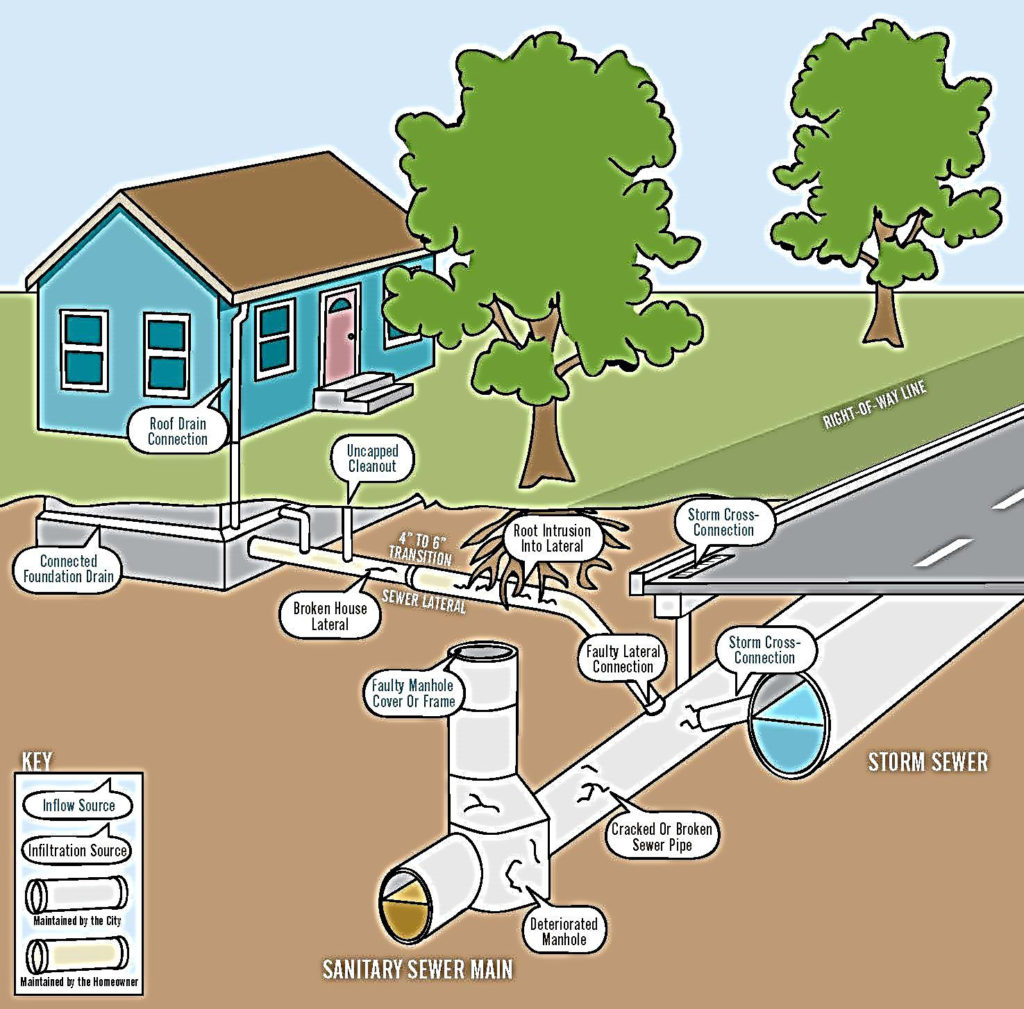Inflow & Infiltration / Time of Sale Inspections
What is Inflow and Infiltration (I&I)?
Inflow and Infiltration (I&I) is the excess flow of clear water into the Town’s sanitary sewer system.
- Inflow is when clear water from illegal connections of sump pumps (see Program Links), downspouts, and foundation drains is channeled directly into sanitary sewer pipes.
- Infiltration is when groundwater seeps into sewer pipes via cracks or leaky joints.
Because the sanitary sewer system was not designed to handle this excess clear water, it becomes overloaded during times of high groundwater or heavy rainfall. This can cause basement flooding or bypassing of raw wastewater to local streams and lakes.
What’s the problem?
Wastewater from the Town of Cheektowaga travels through the Town’s sanitary sewer system to the Main Pumping Station operated by the Town of Cheektowaga. From there waste is transferred to a sewage treatment plant for processing. The Town is charged annually for each gallon of wastewater transmitted and processed by the treatment plant. Including I&I in the wastewater increases treatment costs.
The excess clear water from I&I problems also uses sanitary sewer capacity needed for wastewater. The result is sewer backups and increased costs to homeowners and taxpayers for needlessly putting clear water through the wastewater treatment process.
The New York State Environmental Conservation Department (NYSDEC) requires communities with excess I&I to invest in local reduction remedies such as disconnecting sump pumps and foundation drains from sanitary sewers and repairing leaky sanitary sewer pipes. Such actions will cost roughly $60 million, instead of the estimated $1 billion it would cost to build additional sewer infrastructure to provide capacity during big rain storms. To urge compliance, NYSDEC will fine communities with excess I&I.
The Town of Cheektowaga was identified as a contributor of excess I&I and is working to resolve the problem.
I&I Problem Spots
Drainage from roofs, paved areas, yards and other open areas, if improperly discharged, will lead to I&I issues.
Roof Drains and Leaders
Roof drains and leaders direct storm water from roof gutters to the ground through pipes and downspouts. Roof drains should not be connected to the sanitary sewer but should discharge to the ground outside of a building. If your roof drains are connected to the sanitary sewer, disconnect them, plug any open connections to the sanitary sewer using a non-shrink permanent material, and redirect the roof drains onto the ground outside the building.
Foundation Drains
Foundation drains are underground pipes that collect storm water from around the base of a building and into a sump pit, where it is then pumped outside of the building. Foundation drains should not be connected to the sanitary sewer. If your foundation drain system is connected to the sanitary sewer, correcting the problem could be costly. The process could involve excavation to disconnect the foundation drain from the sanitary sewer and installation of a sump pump system. The new sump system must pump directly to the ground outside of the building or be connected to the Town’s storm sewer system.
Sump Pumps (Also See Program Links)
Sump pumps are designed to capture surface or ground water that enters basements or crawl spaces and pump it away from the house. The basic sump system includes drain tile, a sump pit, a sump pump, a float or switch, and a drain line. The sump pit extends below the slab and collects surface water that enters the basement/crawl space or groundwater that rises to the slab. Sump pumps should not be connected to the sanitary sewer. Sump pumps should drain into the Town’s storm sewer system through one of two methods: a direct connection (a pipe from the house to the main storm sewer line), if available, or directly onto the ground (preferably 20 feet from the house and not into or towards a neighbor’s yard).
The following diagram shows sources of I&I entering the Sanitary Sewer System in a typical residential structure.

I&I Inspections Program
To comply with NYSDEC directives regarding I&I, the Town will inspects home and businesses in The Town of Cheektowaga to determine if roof drains, foundation drains, sump pumps (see Program Links), and other clear water sources are connected to the sanitary sewer system. The goal of this program is to reduce excessive flows that enter the sanitary sewer system so the Town, and its utility customers, won’t have to pay NYSDEC surcharges. The Town is beginning with Time of Sale Inspections March 1, 2016 and will continue with systematic house-to-house and business-to-business inspections later this year.
Who is subject to an inspection?
- All properties in Town of Cheektowaga Consolidated Sewer District must be inspected and required to be in compliance before they can be sold (see Time of Sale Inspections under Program Links). Under the Time of Sale Law, a property must be inspected to ensure that no I&I issues are present. If problems are found, the corrective work must be completed and an inspection called for at least 15 days prior to the date of sale to allow for final inspection. Upon completion of a successful Time of Sale Inspection, the Town of Cheektowaga Building & Plumbing Department issues a Certificate of I&I Compliance. This Certificate is good for 120 days to allow for the completion of the sale of the property.
- Property owners who apply for plumbing permits, variances, subdivisions, or other actions from the Town of Cheektowaga will also be subject to an inspection.
- In the near future the Town will conduct systematic house-to-house and business-to-business inspections to check for I&I issues.
- The Town of Cheektowaga will conduct I&I inspections as part of its annual Pavement Rehabilitation Program. Streets deteriorate as they age, much like the roof and paint on your home. The Town of Cheektowaga’s Pavement Management Program is a comprehensive, systematic way for the Town to evaluate its street system and follow through with long-term, cost-effective maintenance and rehabilitation.
